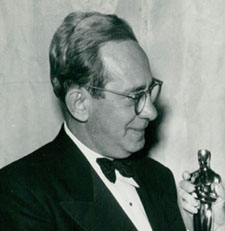Edward Selzer (Edward Selzer)

Edward “Eddie” Selzer (January 12, 1893 – February 22, 1970) was an American cartoon producer and head of Warner Bros. Cartoons from 1944 to 1958. He served in the US Navy and fought as a Golden Gloves boxer. He won a boxing exhibition for the Navy and was awarded with a weekend pass. While out on leave he met a New York chorus girl named Laura Cohn; he later married Laura and relocated to Los Angeles where they had two children; Phyllis and Robert. After the studio was purchased from Leon Schlesinger in 1944, Selzer was assigned studio head by Jack L. Warner. His first cartoon was Goldilocks and the Jivin’ Bears. Unlike his predecessor, Edward Selzer did not want any on-screen credit as producer for Warner Bros. Much of what is publicly known about Selzer’s personality and business acumen is from Chuck Jones’ autobiography, Chuck Amuck: The Life and Times of an Animated Cartoonist. In it, Jones paints Selzer as an interfering bore with no appreciation of animated cartoons. They later developed a mutual respect and understanding of one another, remaining friendly until Selzer’s passing. Friz Freleng nearly resigned after butting heads with Edward Selzer, who did not think that pairing Sylvester the cat and Tweety was a viable decision. The argument reached its crux when Freleng reportedly placed his drawing pencil on Selzer’s desk, furiously telling Selzer that if he knew so much about animation, he should do the work instead. Selzer backed off the issue and apologized to Freleng that evening. Tweetie Pie, the very cartoon that first paired Sylvester and Tweety together, went on to win Warner Brothers’ first Academy Award for Animated Short Film, in 1947, with Tweety and Sylvester proving to be among the most endearing duos in Warner Bros. cartoons. Accepting the Short Subject (Cartoon) award for Tweetie Pie from Shirley Temple at the 20th Academy Awards ceremony on 20 March 1948.
Edward Selzer also forbade Robert McKimson from producing any future cartoons with the Tasmanian Devil in them after seeing the Devil’s premiere short and deeming the creature far too grotesque to be a recurring character. Selzer changed his mind and allowed further Tasmanian Devil cartoons only upon discovering from Jack Warner that Taz was in fact a massive hit with audiences. Selzer’s edict that “camels aren’t funny” inspired Friz Freleng to disprove him by making Sahara Hare, a cartoon in which much of the comedy arises from Yosemite Sam’s attempts to control his dim-witted camel. Chuck Jones and Mike Maltese created Bully for Bugs in direct response to Selzer’s declaration that there was nothing funny about bullfighting. Eddie Selzer was proud of his position as producer of the Looney Tunes series because of the joy the team’s creations brought to so many. Although he loudly (and indelicately) declared that there was nothing funny about a skunk who spoke French, he proudly accepted the Academy Award for Animated Short Film in 1949 – for For Scent-imental Reasons, a Pepé Le Pew cartoon. One day seeing a group of animators laughing over a storyboard he stormed into the room and demanded: “What in the Hell does all of this laughter have to do with the making of animated cartoons?” Selzer retired in 1958, and John Burton became the head of Warner Bros. Cartoons. Eddie Selzer died in 1970. Upon his death, some of his five Academy Award Oscar statues for the winning cartoons he produced were distributed to the crews behind the cartoons; the one for 1957’s Birds Anonymous was given to voice artist Mel Blanc while the one for Tweetie Pie was given to Freleng; the remaining awards are with his family.
Born
- January, 12, 1893
- USA
- New York, New York
Died
- February, 22, 1970
- USA
- Los Angeles, California

